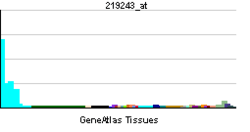GIMAP4
| GIMAP4 | |||||||||||||||
|---|---|---|---|---|---|---|---|---|---|---|---|---|---|---|---|
| |||||||||||||||
| Identifiers | |||||||||||||||
| Aliases | GIMAP4, IAN-1, IAN1, IMAP4, MSTP062, GTPase, IMAP family member 4 | ||||||||||||||
| External IDs | MGI: 1349656 HomoloGene: 75084 GeneCards: GIMAP4 | ||||||||||||||
| RNA expression pattern | |||||||||||||||
 | |||||||||||||||
| More reference expression data | |||||||||||||||
| Orthologs | |||||||||||||||
| Species | Human | Mouse | |||||||||||||
| Entrez | |||||||||||||||
| Ensembl | |||||||||||||||
| UniProt | |||||||||||||||
| RefSeq (mRNA) | |||||||||||||||
| RefSeq (protein) | |||||||||||||||
| Location (UCSC) | Chr 7: 150.57 – 150.57 Mb | Chr 6: 48.68 – 48.69 Mb | |||||||||||||
| PubMed search | [1] | [2] | |||||||||||||
| Wikidata | |||||||||||||||
| View/Edit Human | View/Edit Mouse |
GTPase IMAP family member 4 is an enzyme that in humans is encoded by the GIMAP4 gene.[3][4][5]
This gene encodes a protein belonging to the GTP-binding superfamily and to the immuno-associated nucleotide (IAN) subfamily of nucleotide-binding proteins. The encoded protein of this gene may be negatively regulated by T-cell acute lymphocytic leukemia 1 (TAL1). In humans, the IAN subfamily genes are located in a cluster at 7q36.1.[5]
References
- ↑ "Human PubMed Reference:".
- ↑ "Mouse PubMed Reference:".
- ↑ Krucken J, Schroetel RM, Muller IU, Saidani N, Marinovski P, Benten WP, Stamm O, Wunderlich F (Oct 2004). "Comparative analysis of the human gimap gene cluster encoding a novel GTPase family". Gene. 341: 291–304. doi:10.1016/j.gene.2004.07.005. PMID 15474311.
- ↑ Filen JJ, Filen S, Moulder R, Tuomela S, Ahlfors H, West A, Kouvonen P, Kantola S, Bjorkman M, Katajamaa M, Rasool O, Nyman TA, Lahesmaa R (Jan 2009). "Quantitative proteomics reveals GIMAP family proteins 1 and 4 to be differentially regulated during human T helper cell differentiation". Mol Cell Proteomics. 8 (1): 32–44. doi:10.1074/mcp.M800139-MCP200. PMC 2621005
 . PMID 18701445.
. PMID 18701445. - 1 2 "Entrez Gene: GIMAP4 GTPase, IMAP family member 4".
Further reading
- Dominguez O, Ashhab Y, Sabater L, et al. (1999). "Cloning of ARE-containing genes by AU-motif-directed display.". Genomics. 54 (2): 278–86. doi:10.1006/geno.1998.5548. PMID 9828130.
- Dias Neto E, Correa RG, Verjovski-Almeida S, et al. (2000). "Shotgun sequencing of the human transcriptome with ORF expressed sequence tags.". Proc. Natl. Acad. Sci. U.S.A. 97 (7): 3491–6. doi:10.1073/pnas.97.7.3491. PMC 16267
 . PMID 10737800.
. PMID 10737800. - Stamm O, Krücken J, Schmitt-Wrede HP, et al. (2002). "Human ortholog to mouse gene imap38 encoding an ER-localizable G-protein belongs to a gene family clustered on chromosome 7q32-36.". Gene. 282 (1-2): 159–67. doi:10.1016/S0378-1119(01)00837-X. PMID 11814688.
- Cambot M, Aresta S, Kahn-Perlès B, et al. (2002). "Human immune associated nucleotide 1: a member of a new guanosine triphosphatase family expressed in resting T and B cells.". Blood. 99 (9): 3293–301. doi:10.1182/blood.V99.9.3293. PMID 11964296.
- Strausberg RL, Feingold EA, Grouse LH, et al. (2003). "Generation and initial analysis of more than 15,000 full-length human and mouse cDNA sequences.". Proc. Natl. Acad. Sci. U.S.A. 99 (26): 16899–903. doi:10.1073/pnas.242603899. PMC 139241
 . PMID 12477932.
. PMID 12477932. - Scherer SW, Cheung J, MacDonald JR, et al. (2003). "Human chromosome 7: DNA sequence and biology.". Science. 300 (5620): 767–72. doi:10.1126/science.1083423. PMC 2882961
 . PMID 12690205.
. PMID 12690205. - Ota T, Suzuki Y, Nishikawa T, et al. (2004). "Complete sequencing and characterization of 21,243 full-length human cDNAs.". Nat. Genet. 36 (1): 40–5. doi:10.1038/ng1285. PMID 14702039.
- Gerhard DS, Wagner L, Feingold EA, et al. (2004). "The status, quality, and expansion of the NIH full-length cDNA project: the Mammalian Gene Collection (MGC).". Genome Res. 14 (10B): 2121–7. doi:10.1101/gr.2596504. PMC 528928
 . PMID 15489334.
. PMID 15489334. - Nitta T, Nasreen M, Seike T, et al. (2006). "IAN family critically regulates survival and development of T lymphocytes.". PLoS Biol. 4 (4): e103. doi:10.1371/journal.pbio.0040103. PMC 1393758
 . PMID 16509771.
. PMID 16509771. 
This article is issued from Wikipedia - version of the 5/31/2016. The text is available under the Creative Commons Attribution/Share Alike but additional terms may apply for the media files.